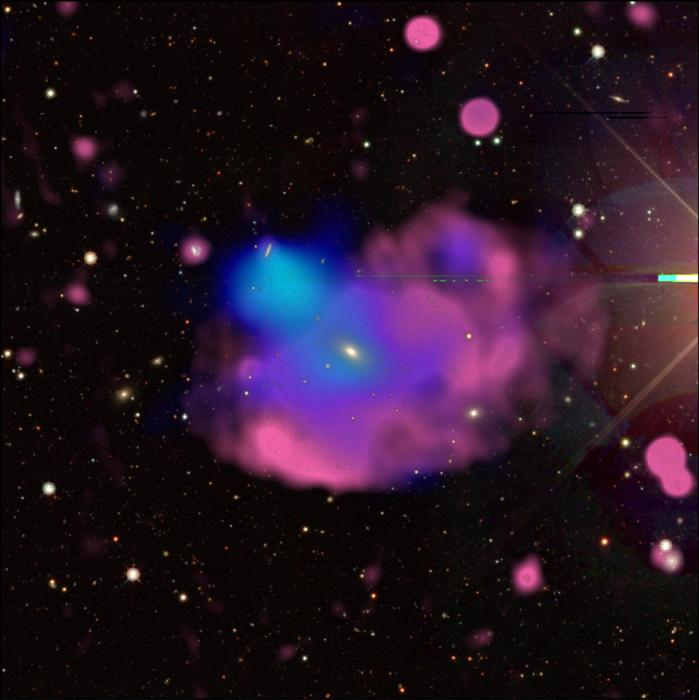Reviewed by Lexie CornerMay 3 2024
Astronomers from NASA’s Goddard Space Flight Center uncovered massive, circular radio structures (known as ORCs) encircling galaxies. X-Ray observations indicate that the Cloverleaf ORC originated from the collision of two galaxy groups. The shockwaves generated by the collision gave rise to radio emissions. These findings were detailed in a study published in Astronomy and Astrophysics Letters.
 This multiwavelength image of the Cloverleaf ORC (odd radio circle) combines visible-light observations from the DESI (Dark Energy Spectroscopic Instrument) Legacy Survey in white and yellow, X-Rays from XMM-Newton in blue, and radio from ASKAP (the Australian Square Kilometer Array Pathfinder) in red. Image Credit: X. Zhang and M. Kluge (MPE), B. Koribalski (CSIRO).
This multiwavelength image of the Cloverleaf ORC (odd radio circle) combines visible-light observations from the DESI (Dark Energy Spectroscopic Instrument) Legacy Survey in white and yellow, X-Rays from XMM-Newton in blue, and radio from ASKAP (the Australian Square Kilometer Array Pathfinder) in red. Image Credit: X. Zhang and M. Kluge (MPE), B. Koribalski (CSIRO).
Examining these structures, ORCs, under a different wavelength allowed scientists to investigate a range of phenomena, from supersonic shock waves to black hole dynamics.
This is the first time anyone has seen X-Ray emission associated with an ORC. It was the missing key to unlock the secret of the Cloverleaf’s formation.
Esra Bulbul, Astrophysicist, Max Planck Institute for Extraterrestrial Physics
A Serendipitous Discovery
Before 2021, the existence of ORCs remained unknown. Advances in technology enhanced the sensitivity of radio surveys, enabling the detection of these faint signals. Over a span of a few years, astronomers identified eight of these peculiar structures dispersed haphazardly beyond the galaxy, each large enough to encompass an entire galaxy, sometimes multiple.
Bulbul states, “The power needed to produce such an expansive radio emission is very strong. Some simulations can reproduce their shapes but not their intensity. No simulations explain how to create ORCs.”
Upon discovering that ORCs had not been examined in X-Ray light, Bulbul and Postdoctoral Researcher Xiaoyuan Zhang meticulously scrutinized data from eROSITA (Extended Roentgen Survey with an Imaging Telescope Array), a German/Russian X-Ray telescope in orbit. Based on less than seven minutes of observation time, they observed some X-Ray emission that appeared to originate from the Cloverleaf.
This evidence provided a compelling rationale for assembling a larger team and securing additional telescope time with XMM-Newton, an ESA (European Space Agency) mission with contributions from NASA.
Bulbul adds, “We were allotted about five-and-a-half hours, and the data came in late one evening in November. I forwarded it to Xiaoyuan, and he came into my office the next morning and said, ‘Detection,’ and I just started cheering!”
We really got lucky. We saw several plausible X-Ray point sources close to the ORC in eROSITA observations, but not the expanded emission we saw with XMM-Newton. It turns out the eROSITA sources couldn’t have been from the Cloverleaf, but it was compelling enough to get us to take a closer look.
Xiaoyuan Zhang, Postdoctoral Researcher, Max Planck Institute for Extraterrestrial Physics
Gallivanting Galaxies
The X-Ray emission delineates the distribution of gas within the group of galaxies, akin to police tape encircling a crime scene. By examining the perturbation of this gas, scientists concluded that the galaxies within the Cloverleaf are, in fact, members of two distinct groups that merged upon drawing close to each other.
The emission temperature also provides clues regarding the number of galaxies implicated in the process.
As galaxies merge, their increased combined mass enhances gravitational forces. Consequently, surrounding gas starts to collapse inward, leading to the heating of the infalling gas. This heating effect intensifies with the greater mass of the system.
According to the X-Ray spectrum of the emission, its temperature registers approximately 15 million degrees Fahrenheit, equivalent to between 8 and 9 million degrees Celsius. “That measurement let us deduce that the Cloverleaf ORC is hosted by around a dozen galaxies that have gravitated together, which agrees with what we see in deep visible light images,” Zhang said.
The team suggests that the merger generated shock waves, which in turn accelerated particles, resulting in the production of radio emissions.
Galaxies interact and coalesce all the time. But the source of the accelerated particles is unclear. One fascinating idea for the powerful radio signal is that the resident supermassive black holes went through episodes of extreme activity in the past, and relic electrons from that ancient activity were reaccelerated by this merging event.
Kim Weaver, Project Scientist, XMM-Newton, NASA’s Goddard Space Flight Center
Kim Weaver was not involved in the study.
While mergers of galaxy groups are commonplace, ORCs are exceedingly rare, and the mechanism behind the generation of such potent radio emissions remains uncertain.
Bulbul notes, “Mergers make up the backbone of structure formation, but there’s something special in this system that rockets the radio emission. We can’t tell right now what it is, so we need more and deeper data from both radio and X-Ray telescopes.”
The team unraveled the mystery surrounding the nature of the Cloverleaf ORC but also unearthed additional inquiries. They intend to conduct further detailed studies of the Cloverleaf to elucidate these answers.
Weaver concludes, “We stand to learn a lot from more thorough observations because these interactions take in all kinds of science. You’ve pretty much got everything that we deal with in the cosmos put together in this little package. It’s like a mini-universe.”
Journal Reference:
Bulbul, E., et al. (2024) The galaxy group merger origin of the Cloverleaf odd radio circle system. Astronomy & Astrophysics. doi.org/10.1051/0004-6361/202449900.